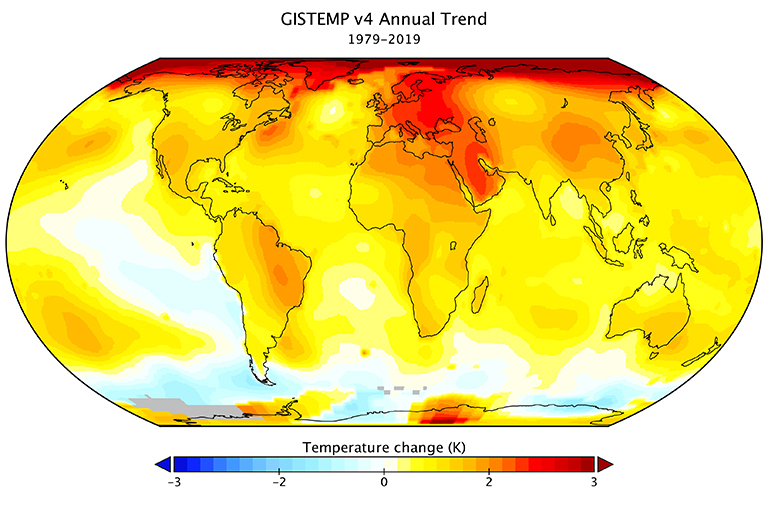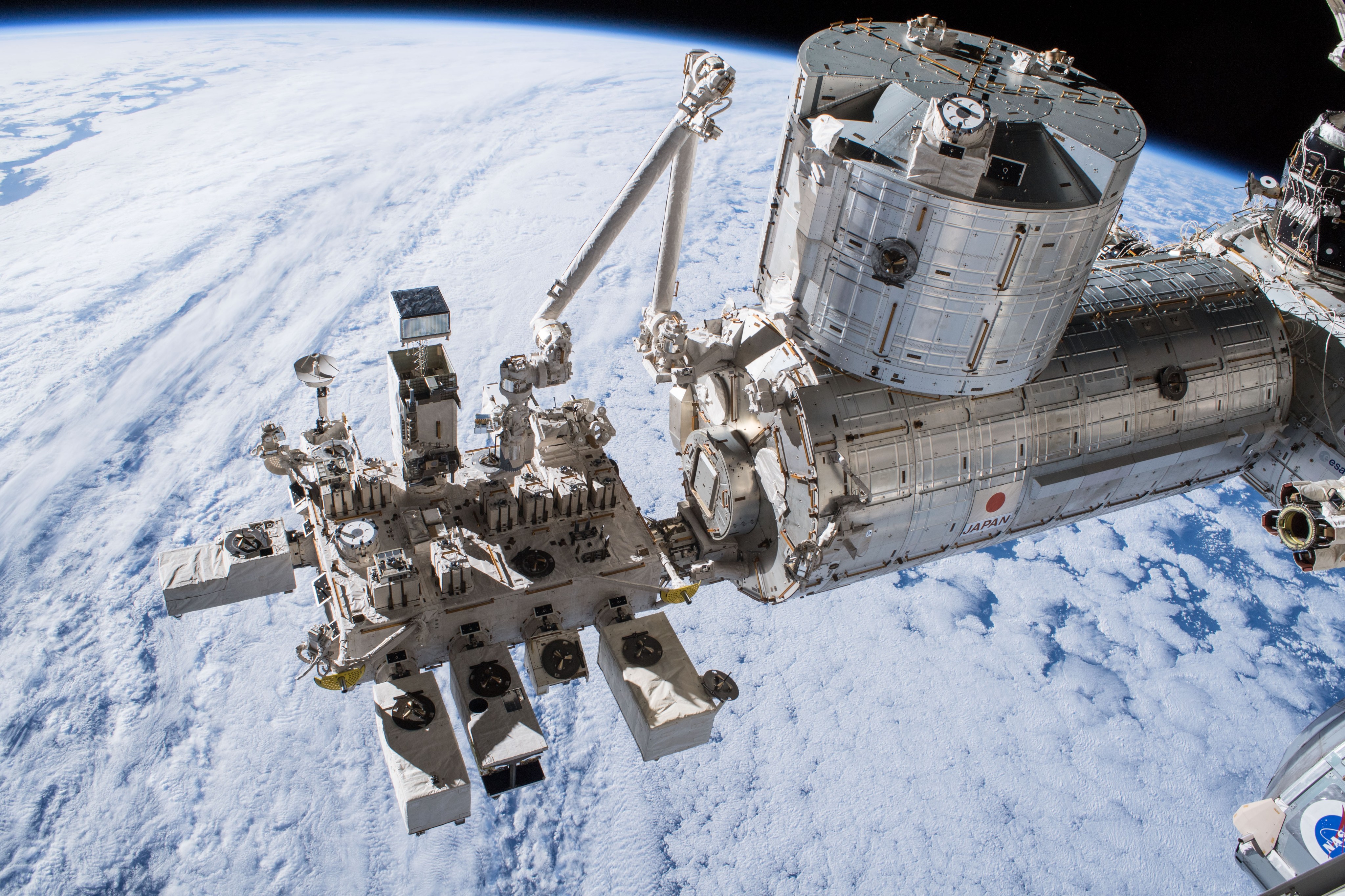11 min read
New Study Narrows the Range of Uncertainty in Future Climate Projections

Recently, an international research team published a comprehensive review in the journal Reviews of Geophysics on our state of understanding of Earth's "climate sensitivity," a key measure of how much our climate will change as greenhouse gas emissions increase. Essentially, by narrowing the range of estimates, the researchers found that climate sensitivity isn’t so low that it should be ignored, but it’s also not so high that there is no hope for the planet’s recovery.
We asked the two NASA authors on the study — Kate Marvel, jointly of Columbia University in New York and NASA’s Goddard Institute of Space Studies (GISS) in New York; and GISS Director Gavin Schmidt — to discuss their roles in the study and its significance for understanding the impacts of our warming world on climate.
Q. What exactly is climate sensitivity and why is it important to know its true value?
Schmidt: “We know from studies of the past that Earth’s climate can change dramatically. The evidence shows that the amount of greenhouse gases in the atmosphere can vary over time and make a big difference to the climate. Scientists try to quantify that by estimating how much the surface air temperature, averaged over the whole globe, would change if we doubled the amount of one typical but specific greenhouse gas – carbon dioxide. That number, called climate sensitivity, has quite a wide uncertainty range, and that has big implications for how serious human-made climate change will be.”
Q. Your team was able to narrow the range of estimates of Earth's climate sensitivity by more than 43 percent, from the previously accepted range of 1.5 to 4.5 Kelvin first established in 1979 (roughly 3 to 9 degrees Fahrenheit), to a narrower range of 2.6 to 3.9 Kelvin (roughly 4.5 to 7 degrees Fahrenheit). Why is it important for scientists to narrow this range of uncertainty? What does it mean in practical terms to be able to reduce uncertainties in measuring climate sensitivity?
Schmidt: “Scientists would like to reduce that uncertainty so that we can have more confidence in how we need to mitigate and adapt to future changes. For instance, how much sea level might rise, or how heat waves will get worse, or rainfall patterns change, are tied to the climate sensitivity combined with our actions in changing the atmosphere. A higher climate sensitivity would mean we would have to do more to avoid big changes, while a lower value would mean we’d have more time to adapt. It’s useful to note that we expect to reach double carbon dioxide levels later this century, and that while a few degrees might not seem like much, it's a big deal for the planet. The difference between forests beyond the Arctic Circle or glaciers extending down to New York City is only a range of about 8 K (about 14 degrees Fahrenheit) in the global average, while it changes sea level by 150 meters (more than 400 feet)!”
Q. How can better estimates of climate sensitivity impact policy decisions?
Marvel: “The most important thing about climate sensitivity is that it's not zero. Increasing atmospheric carbon dioxide definitely makes it warmer and increases the risk of extreme weather like drought, downpours, and heat waves. But better estimates of climate sensitivity are important for motivating action. Our results show that it would be foolish to rely on nature to save us from climate change — we don't think it's likely that sensitivity is low. But conversely, it's unlikely that climate sensitivity is so high as to make action pointless.”
Schmidt: “I’m not sure that our policy decisions are that finely tuned to the science of climate sensitivity other than knowing that climate really is sensitive to increasing greenhouse gases. Many climate policies are robust to those uncertainties, but many adaptation decisions will depend on knowing how bad things will get.”
Q. Why has it been so difficult over the past 40 years to narrow this range? What made this new estimate possible?
Schmidt: “There are three main reasons why this has been difficult. First, knowledge of past climate change has been difficult to quantify in globally coherent ways. Of course, we have known about the ice ages for a century or more, but getting accurate estimates of the global changes in temperature, greenhouse gases, and ice sheets has taken time and has needed many scientists working on many different aspects of the problem to come together. Second, the climate change signal has taken time to come out of the ‘noise’ of normal variability. In the 1980s and 1990s, people were still arguing about whether the warming over the 20th century was significant, but with another 20 years of record-breaking temperatures, that has been very clearly shown. Third, our understanding of the processes in the climate that affect sensitivity — clouds, water vapor, aerosols, etc. — has improved immensely with the development of satellite remote sensing, and every decade we are producing better and more useful information. But as these lines of evidence have matured, the need to come up with new methods to tie them all together coherently has become acute — and that was the impetus for this roughly 4-year effort.”
Marvel: “Yes, and in modeling, clouds are some of the biggest wildcards. See go.ted.com/katemarvel.”
Q. What types of evidence did the team consider in reaching its conclusions? Where do the lines of evidence agree and disagree most substantially?
Schmidt: “There are three main sources of information: changes since the late 19th century that have been measured in real time, our understanding of physical processes (particularly clouds), and new and more complete information from periods in the paleoclimate record (the geological past) where the planet was significantly cooler or warmer than today. All of the lines of evidence are mostly commensurate, but specific issues mean that the recent record isn’t good at constraining the high-end values because of the imprecise role of aerosols, and paleoclimate change is less able to constrain the low end because of the uncertain nature of that data. Together, however, we can mostly rule those tails out.”
Q. What were a few of the most significant findings for each of the three lines of evidence studied (feedback processes, the historical warming record, and paleoclimate records)?
Marvel: “For a long time, many people thought that sensitivity estimates derived from paleoclimate — the far past — were incompatible with estimates derived from more recent observations. But there's a difference between a past climate state in which the planet has reached an equilibrium — a ‘new normal’ — and our current climate, where things are very much in flux and continuing to change. There is some uncertainty in just how different the future will look from what we're experiencing now — it's possible we're moving into a new world for which we don't have a recent analogue. And when we take that uncertainty into account in a rigorous way, we find that the far past and the near future may not be telling us such different things after all.”
Schmidt: “What was interesting was that by starting off with a view of climate sensitivity that was a little more sophisticated than people had used previously, we found that there was more coherence among the different lines of evidence than others had found, and since the information we are using really is very independent, that allowed us to narrow the uncertainty.”
Q. Your team used a "Bayesian approach" to calculate your estimated range of climate sensitivity. In layman's terms, what is that?
Schmidt: “A Bayesian approach is really just a mathematical representation of how we do science in general. We have an initial hypothesis, we get some evidence that may or may not support it, and then we update our understanding based on that evidence. And then we do it again (and again, and again, etc.). Over time, and as more evidence accumulates, we hopefully hone in on the most correct answer. Using Bayesian methods allowed us to pull together disparate threads of evidence in a coherent way — allowing for different degrees of confidence in each of the lines of evidence. What is great is that in the future, as more evidence is discovered, we can continue the process and update our understanding again.”
Q. What role did global climate models play in the team's findings?
Marvel: “Complex climate models are useful tools (see here for a good overview). But in this paper, we relied largely on observations: satellite and ground-based measurements of recent trends, paleoclimate datasets, and basic physical principles.”
Schmidt: “Climate models help frame the questions we are asking and can be examined to see how climate patterns in space and time connect to things we can directly observe. But we know that climate models have a lot of uncertainty related (for instance) to cloud processes, and so we didn’t use them directly to estimate sensitivity. You could, however, use our results to assess whether a climate model has a sensitivity that is within our independently constrained range.”
Q. Your new estimated range of Earth's climate sensitivity finds the value is around the mid-point of the previous estimate range rather than on the lower or higher end. What does that mean in practical terms for projections of Earth's global temperatures and Earth's climate in this century?
Schmidt: “It means that climate sensitivity is not so low that we can ignore it, nor is it so high that we should despair. Ultimately, it tells us that while human-made climate change is (and will continue to be) a problem, our actions as a society can change that trajectory.”
Q. How likely is it that Earth's climate sensitivity could be higher than 3.9 Kelvin? Lower than 2.6 Kelvin?
Schmidt: “There are subjective elements to the analysis we performed, and other people could decide to weight things a little differently. We explored some of these alternative choices and that broadens the uncertainty a little, but basically, we estimate that there is about a one-in-six chance that it was less than the low end, and one-in-six that it was higher than the high end. That’s not impossible, but, if true, then a lot of our assessments would have to be quite a ways off.”
Q. The concentration of carbon dioxide in Earth's atmosphere is currently around 414 ppm (parts per million). What are the projections for future carbon dioxide increases under the range of current emissions scenarios and how does having a better estimate of climate sensitivity improve our understanding of how our climate may change in the future?
Schmidt: “The future trajectory of carbon dioxide will depend on what we do as a society — if we decide to burn all the fossil fuels we can find, we could reach 900 ppm by the end of the century, but if we aggressively reduce emissions, we could stay below 500 ppm, maybe lower. The climate sensitivity tells us what we can expect in terms of temperature — between another 1 or 2 degrees Celsius (1.8 or 3.6 degrees Fahrenheit) for the low scenario, which would be very serious, to between 4 and 7 degrees Celsius (7.2 and 12.6 degrees Fahrenheit) for the high end scenario, which would be a disaster.”
Q. What about your study did you find most surprising?
Marvel: “How difficult it was to get everyone with all their different expertise working together on a big, joint effort. In the end, I think everyone realized how important it was and how this will be a strong basis for everyone’s future research.”
Schmidt: “How consistent the results were across all three different approaches.”
Q. What was your role in the study?
Marvel: “I was one of the lead scientists on the section looking at historical constraints on sensitivity, making sure that we took into account the differences in how things changed over the 20th century and how things will change going forward, and working to make sure that the uncertainties in historical climate records were properly included.”
Schmidt: “I worked mainly on the paleoclimate section, making sure that we used the most appropriate data from key periods in the planet’s history (like the last ice age or the last time carbon dioxide was as high as it is now — some 3 million years ago).”






